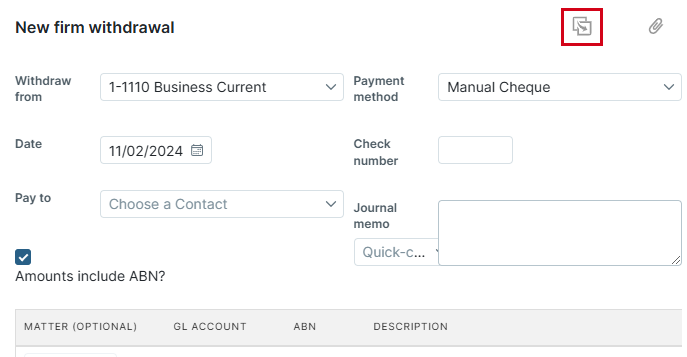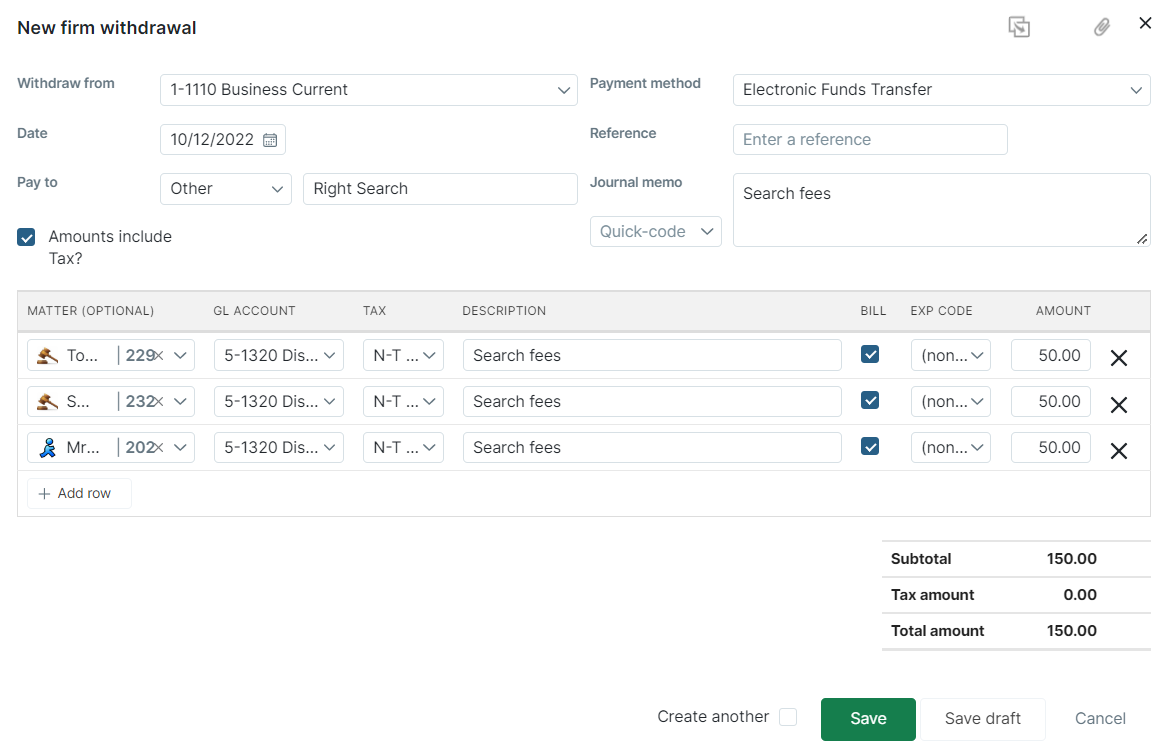A firm withdrawal is a transaction that involves removing money from your bank account to pay an expense. In Actionstep, a firm withdrawal transaction is not for paying a supplier invoice. It is for paying an expense that you did not get invoiced for.
Creating a New Firm Withdrawal

You can also set defaults for the Firm Withdrawal form so that some of the fields in the form are automatically filled out. An admin can refer to Setting Your Main Accounting Preferences (Admin) for more information.
To create a firm withdrawal:
- In Actionstep, click the global Create button and choose Firm Withdrawal from the Accounting section. (You may need to click Show all to view the complete list of options.)
 The New Firm Withdrawal window appears.
The New Firm Withdrawal window appears.
- Complete the following fields:
- Withdraw from: Choose the bank account the withdrawal will be made from. Trust bank accounts are not displayed.
- Date: Enter the date the withdrawal will be made.
- Pay to: Enter the contact the payment will be made to.
- Amounts include ABN/GST/VAT: Select this option to include sales tax in the payment. (This option is available only if you have sales tax such as GST or VAT set in your system.)
- Payment method: Select how the payment will be processed. Which option you chose determines which field appears below it. For example, if you choose Printed check, you will enter the Check number. If you choose Electronic funds transfer, you will enter a Reference.
- Journal Memo: Enter a memo or note for this transaction. To use a pre-set list of memos, choose it from the Quick-code drop-down list. (Quick-code options can be set by your admin.)
- In the table, click Add row and provide the following details:
- Matter (Optional): Use this to search for and select a matter to associate with the withdrawal. This option is used if you need to associate the firm withdrawal payment with a client or monitor the costs associated with a matter. (Even if you're not going to bill your client for a firm withdrawal, you may want to still associate it with a matter. Reports like the Multi Matter Profitability Report give you insight into your profitable matters if you record costs against them.)
- GL Account: Enter the general ledger account that you would like this item posted to. (This information is required.)
- GST/ABN/VAT: Choose what sales tax rate will be applied to this line item.
- Description: Enter the description of the line item. If left blank, the line item description will use the text entered for the Journal memo.
- Bill: Select this option to have Actionstep automatically create a billable expense record for the appropriate matter. The next time you bill that matter, the expense will be included in that bill. (Please note that to bill this cost on to a client you will need to ensure the following are included: Matter is filled in, Bill is selected, Exp code is filled in (if your client requires UTBMS codes), and an Amount is entered.)
- Exp Code: Enter the required code. NOTE: UTBMS (or Uniform Task-Based Management System) is a process where the items you bill are categorized based on a fixed set of codes. Some law firm clients require this information to help them understand the breakdown of what they are being billed for. If your firm does not bill using LEDES or UTBMS, you can ignore this option.
- Amount: Enter the amount for the line item.
- Click Add row to create another line item and provide the required information, as explained previously.
- Optionally, if you have supporting documents (like receipts) you want associated with the withdrawal, click the paperclip icon at the top of the window and then browse to and select the documents you want uploaded. Click the icon again to view and download the documents.
- When you're finished entering the details, click Save to save your changes. (Select Create another if you have another firm withdrawal you need to create.)
• If you have a supplier invoice with different sales tax rates applied to different line items, you should at least create a separate line in the supplier invoice for each tax rate to ensure that your taxes are recorded correctly.
• You might also receive a supplier invoice for items that would be coded against different expense codes. In this case, it might be worthwhile to create different line items for each expense code. For example, you might get a supplier invoice from your local office supplies store for pens, paper, etc. If this is all that the order is for you could create one line item coded to your General Expenses expense account. However, if you purchased a new computer from the office supplies store but also got some paperclips, the supplier invoice would have one line coded to your Computer Expenses account and another line coded to your General Expenses account.
• If you have different items in the supplier invoice that relate to different matters, you will have to create a line per matter.
Accessing your Previous Firm Withdrawals
Firm withdrawals are considered banking transactions which means you can find them included in the list of transactions for your bank.
To do this:
- In Actionstep, go to Accounting > Banking. The Banking page appears.
- Find the bank account the transaction should have been made from.
- Click the ellipses icon for the bank and choose Transactions from the View section on the menu. The Transactions page appears.
The listed transactions include all transactions for that bank account. To see just the firm withdrawals, click the Filter drop-down list and filter the Entry type by Firm withdrawal.

Related Articles:
Was this article helpful?
That’s Great!
Thank you for your feedback
Sorry! We couldn't be helpful
Thank you for your feedback
Feedback sent
We appreciate your effort and will try to fix the article